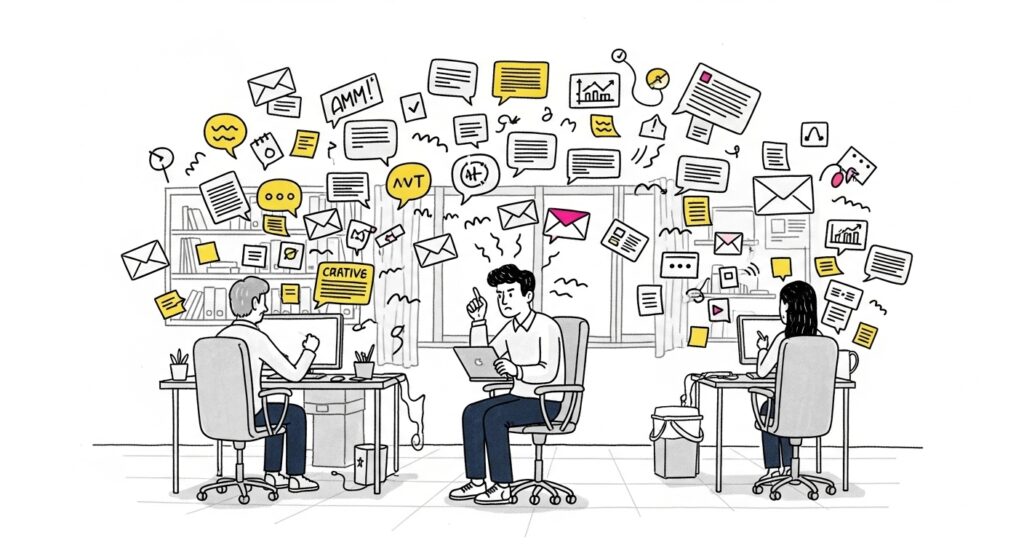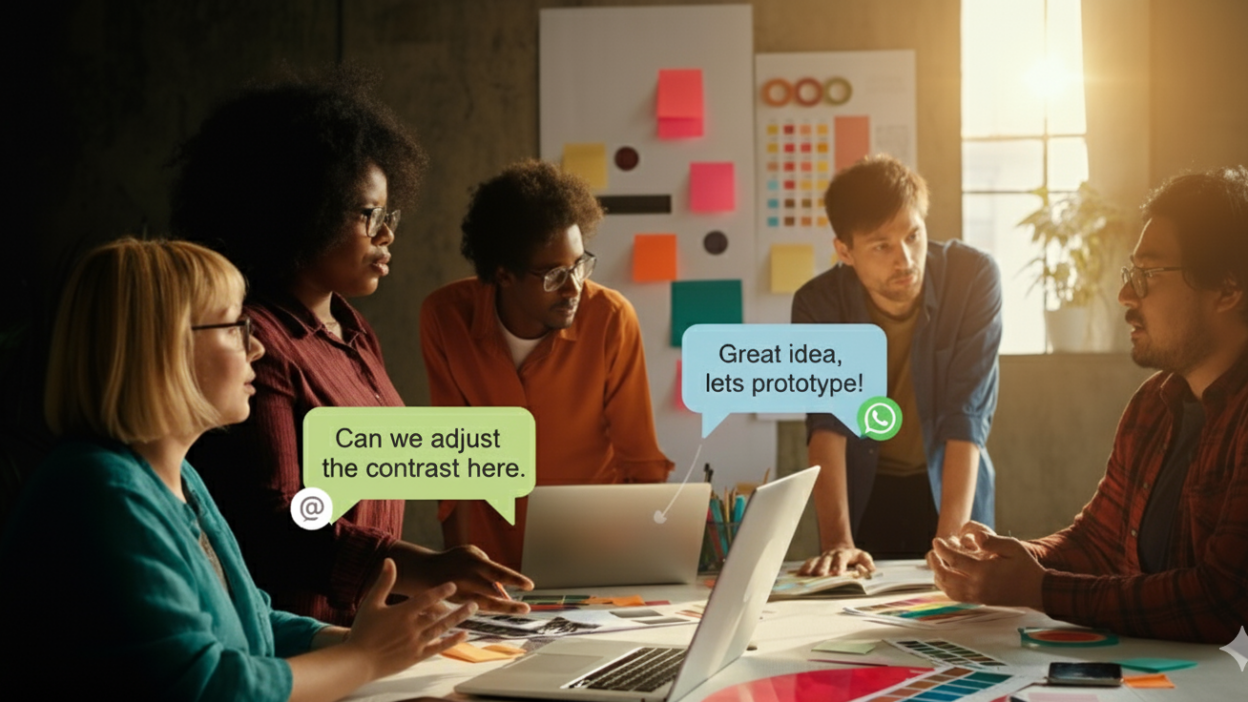Alright, picture this- You’ve just finished a project you’re genuinely proud of: a new logo, a website design, or a video campaign. After a week of intense focus and creative flow, you send it off to the team for feedback and wait. A few hours later, the replies start coming in from every direction: a quick email suggesting a different shade of blue, a Slack message about a new font, a comment on a Google Doc pointing out a typo, and a long, rambling voice note on WhatsApp explaining the overall “feel.” Suddenly, what should have been a smooth creative process turns into a scattered hunt for clarity.
All of this unstructured feedback leaves you with more questions than answers, right?
Well, this isn’t teamwork; it’s a digital scavenger hunt. You’re left sifting through fragmented, contradictory notes across five platforms, and an hour later, you’re still unsure what the core feedback even is. So, you set up an online meeting for clarity, but instead, it makes the creative process slide further downhill. The MOMs from that meeting inevitably conflict with earlier feedback buried in some chat. What have you really lost? Not just hours of work, but the creative headspace you needed to move forward. What once felt like a fluid process suddenly hits a wall.
The Unspoken Ideal of the Creative Workflow
What does a smooth creative process even look like? It’s not about being a robot, but about having a clear path from idea to execution. It’s a workflow that allows creative people to do what they do best: create.
An ideal workflow for a creative team would look something like this:
- Ideate & Create: The team brainstorms, sketches, and builds the first version of a project. The energy is high, the focus is clear.
- Share & Collaborate: The work is shared in a single, dedicated space. Teammates can see the work and add their thoughts in one place.
- Refine & Iterate: Feedback is organized, clear, and actionable. The creator knows exactly what to do, and they can make the changes efficiently.
- Finalize: The team signs off on the final version, and the project is ready to go.
Simple, right? The reality, however, is a tangled mess of different tools, each meant for a different purpose but used for everything. This is where the bottlenecks begin.
The Bottlenecks That Steal Your Time
Think about your last project. How many different tools did your team use for communication and collaboration? The average creative team today uses a mix of:
- Email: Handy for sharing updates, but it’s where important feedback often gets buried under newsletters, notifications, and endless threads.
- Slack/Microsoft Teams: Great for quick chats and asking questions, but not so for organizing long-form feedback or design critiques.
- Google Drive: Perfect for file storage, but comments can be messy, and there’s no central hub for the entire conversation.
- WhatsApp/Voice Notes: Fast and convenient in the moment, but tricky later. Long voice notes or scattered chats are hard to search, and harder to turn into clear action.
- Video Calls (Google Meet, Zoom): Live feedback is great, but once the call ends, the real work begins – deciphering what was said, documenting it all, and then chasing follow-ups until things are finally closed.
Each of these tools has its strengths, but are they designed to handle the visual and multi-layered nature of creative work? Not really! And when you use them all for the same thing, the information gets fragmented. A comment on a design file, a suggestion in an email, and a quick thought in a Slack message are three separate pieces of a puzzle that the creator is left to solve.

Source: Adgully
The Pain of Unstructured Feedback

Scattered tools are just the beginning. The real slowdown comes from the unstructured nature of the feedback itself. These tools were built for general communication, not for the specific needs of design and creative work.
Imagine you’re a designer getting feedback on a logo. In an ideal world, the feedback would be tied directly to the design, with a clear note pointing to the specific part being discussed. Instead, you get a generic message: “The logo feels a bit cold. Maybe add some warmth?”
- The Problem with Vague Language: What does “cold” mean? Does it refer to the color, the font, the shape, or the overall feeling? The creator has to guess, which leads to multiple revisions based on an assumption, not a clear direction.
- The Problem with Irrelevance: In a long email thread, a comment from a week ago might suddenly resurface, but it’s no longer relevant to the current version of the project. This creates confusion and wastes time.
- The Problem with Context: When feedback is disconnected from the work itself, it loses context. A team member might suggest a change without seeing the latest version of the design, leading to a back-and-forth that could have been avoided.
- The Problem with Deciphering: Deciphering isn’t just about understanding a single piece of feedback, it’s about tracing it back to where it came from, who said it, and which version of the creative it even refers to? When feedback is buried inside group chats or scattered across platforms, creators spend more time hunting it down and figuring out its context than actually working on the project itself.

Source: Campaign Asia
As highlighted in this article, poor feedback and subjectivity are among the biggest reasons creative output gets stifled in the industry. The time taken to decipher information and consolidate it is the single most reason for the slow down in the creative process.
A creator’s time is valuable. It should be spent creating, not collating fragmented feedback from different platforms. This fragmented approach not only slows down the project but also kills the creative momentum. The magic of the creative process fades as frustration sets in.
A Better Way Forward
So, what’s the answer? It’s not about getting rid of these tools entirely. It’s about recognizing their limitations and introducing a centralized hub for your creative process and feedback. You need a dedicated tool, something built specifically for creative teams that can do three things:
- Consolidate: Bring all your feedback into a single, centralized location. Whether it’s a design file, a video, or a document, all comments and conversations should live in one place, tied directly to the asset. With ButtonShift’s Feedback tool, this happens naturally within the creative workflow, so everything is right where you need it.
- Contextualize: Feedback only works when it’s clear and actionable. Instead of vague notes in a separate chat or email, ButtonShift allows feedback comments to be pinned to a specific area on an image, a frame in a video, or even a section of a PDF or audio file. This makes feedback visual and precise, eliminating guesswork and keeping revisions sharp.
- Seamless Approvals: Feedback is only half the battle, projects need to move forward. With ButtonShift’s Workflow, reviews and approvals are built right into the process. Stakeholders can approve or request changes in sequence, ensuring nothing stalls in limbo. This kind of system is exactly how creative teams can tackle workflow challenges and keep projects moving smoothly from idea to execution..
By implementing these small but mighty changes, you can reclaim your time and energy. You can transform the feedback stage from a frustrating bottleneck into a smooth, efficient part of your workflow. This allows the team to spend their time on what truly matters: making great work. And isn’t that the point of a great creative process in the first place?

The Bottom Line
The creative process will never be perfectly linear (and honestly, would we want it to be?). A little chaos is part of the magic. But too much chaos like scattered tools, unstructured feedback, unclear decisions, kills momentum and frustrates teams.
The fix isn’t complicated. Bring files and feedback together. Set simple rules for how and when feedback happens. Make approvals transparent. Reflect after each project.
This won’t strip the fun out of creativity, it’ll protect it. Because when you cut through the noise, creative teams finally get to focus on what they do best: creating work that matters.Ready to spend less time chasing feedback and more time creating? Try ButtonShift and see how effortless the creative process can be.



